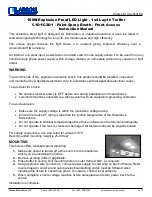
12
Transporting
For maximum ground clearance, transport the blade
to and from work areas fully raised and angled straight
ahead.
Starting & Stopping
1. Start the tractor engine. Set engine throttle to full.
2. Raise the attachment lift and travel to the work site.
3. Set the angling control to the desired angle.
4. Lower the attachment lift and begin plowing.
5. Raise the plow before backing up.
6. To stop the tractor, set ground speed to neutral and set
the parking brake. Before leaving the seat, stop the
engine, set the parking brake, remove the key, and wait
for all moving parts to stop.
Changing Angle of the Blade:
See Figure 1 for location of Controls.
NOTE:
It is easier to change the angle of the blade with the
attachment raised.
1. Raise the attachment lift.
2. Turn the lever counterclockwise to release the angling
mechanism and move the blade left or right. Push the
angling lever forward fully to lock the blade in the left
position. Pull the lever fully back to lock the blade in the
right position. Move the lever slowly over center to lock
in the centered position.
Snow Plowing Tips
• Determine the best snow removal pattern before
beginning.
• Plan the pattern so that you avoid pushing snow onto
cleared areas.
• When land contour permits, it is best to travel in the
longest direction to minimize turning.
• In very deep or heavy snow, it may be necessary to
make the first pass with dozer blade partially raised,
then repeat each pass with the blade lowered to
clear the material left on the surface. Also, it may be
necessary to clear less than the full width of the dozer
blade or reduce ground speed.
• Snow tends to freeze into solid banks when plowed off
a driveway or other large area. Because of this you
may want to plow snow several feet past the edge of
the drive to allow space for future plowing to build up.
• If pushing snow past the edges of driveways or
sidewalks, be careful not to tear up the grass buried
under snow next to the drive or sidewalk. Lift the blade
several inches off the ground to avoid damaging the
grass.
• Spinning tires with tire chains can leave unsightly marks
or permanent damage to asphalt or concrete driveways
or sidewalks. Avoid sudden stops or starts.
DANGER
OPERATING ON SLOPES CAN BE DANGEROUS
Never operate on slopes greater than 17.6% (10°)
which is a rise of 3-1/2 feet (106cm) vertically in 10 feet
(607cm) horizontally.
Operate the unit at a slow ground speed when driving
onto slope. Avoid using brakes to control ground speed.
When operating on slopes that are greater than 15 %
(8.5°) but less than 17.6%, use additional wheel weights
or counterweights.
In addition to counterweights, use extra caution when
operating on slopes. Drive UP and DOWN the slope,
never across the face, use caution when changing
directions and DO NOT START OR STOP ON SLOPE.
For additional traction, tire chains and a weight box can
be added. Maximum weight added to tractor should
not exceed 35 lbs. per wheel and 100 additional lbs. in
weight box.
IMPORTANT
Note:
To prevent damage to the unit, always raise the dozer
blade BEFORE turning or backing up.
WARNING
Perform the Safety System Interlock test found in your
tractor Operator’s Manual. If tractor does not pass the
test, do not operate the tractor. See your authorized
dealer. Under no circumstances should you attempt to
defeat the safety system.
Use caution when plowing a snow covered area. Snow
can cover objects such as curbs, drop-offs, and other
obstacles. Be familiar with the area you are plowing.
To prevent an explosion or fire, never store the tractor
with fuel in the tank inside a building where an ignition
source is present.
Checks Before Starting
1. Refer to the Maintenance & Adjustments sections of
this manual and perform any needed service. Also,
refer to the tractor Operator’s Manual and perform any
required service.
2. Remove any objects from the work area which might
interfere with plowing activity.
3. Adjust the skid shoes to desired height. See Skid Shoe
Adjustment.
4. Make sure all hardware is present and secure.
Engine & Ground Speed Selection
Always run the engine at full throttle.
Set tractor speed to obtain the needed power to move
the material. Operate at a safe speed, depending on
conditions, so that you have complete control of the
tractor. Rear wheel weights and chains are recommended
for slippery surfaces.
A rear weight carrier is recommended for additional
traction.
Operations
Not
for
Reproduction
Содержание 1694919
Страница 2: ...2 N o t f o r R e p r o d u c t i o n...






































